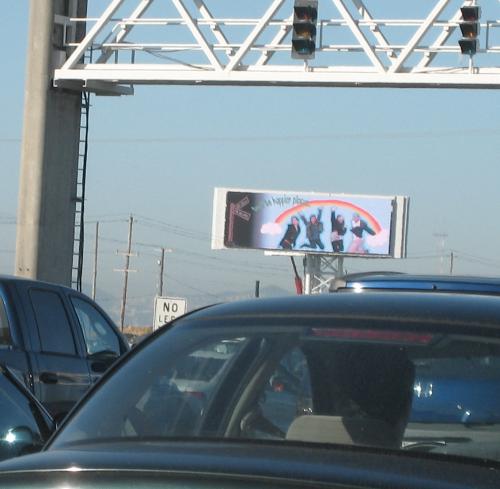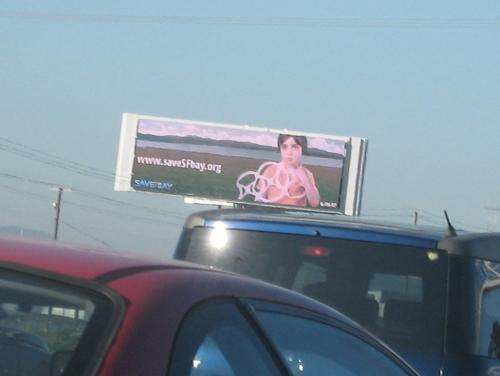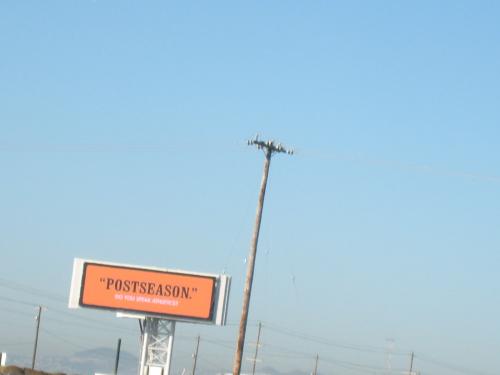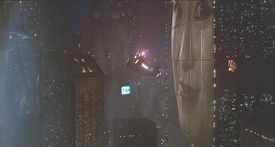I drive the Bay Bridge just about every work day. I'm not proud of this fact. I never expected to be one of those dreaded suburban commuters, living off urban sprawl, the sole occupant of a compact car inching through rush hour traffic twice a day.So sue me. Or better yet, give me enough money to afford a house in San Francisco. Until then, Berkeley it is.But on my morning drive last week I saw a new feature amid the landscape of cargo containers that borders the southern side of the Bay Bridge toll plaza—that's on the East Bay side. It was a new billboard, depicted above. I have no idea how it works. But damn, is it bright. It's an active surface—it changes, presumably according to programming, cycling through a bunch of different ads. So what? Well, for one thing, it's the biggest, brightest one of these kind of signs I've ever seen, high resolution and bright enough to be seen in stark California sunlight. And second, it's just another step in the Blade Runnerfication of our cities.Not that there's anything wrong with that. More after the jump.
 I drive the Bay Bridge just about every work day. I'm not proud of this fact. I never expected to be one of those dreaded suburban commuters, living off urban sprawl, the sole occupant of a compact car inching through rush hour traffic twice a day.
I drive the Bay Bridge just about every work day. I'm not proud of this fact. I never expected to be one of those dreaded suburban commuters, living off urban sprawl, the sole occupant of a compact car inching through rush hour traffic twice a day.
So sue me. Or better yet, give me enough money to afford a house in San Francisco. Until then, Berkeley it is.
But on my morning drive last week I saw a new feature amid the landscape of cargo containers that borders the southern side of the Bay Bridge toll plaza-that's on the East Bay side. It was a new billboard, depicted above. I have no idea how it works. But damn, is it bright. It's an active surface-it changes, presumably according to programming, cycling through a bunch of different ads. So what? Well, for one thing, it's the biggest, brightest one of these kind of signs I've ever seen, high resolution and bright enough to be seen in stark California sunlight. And second, it's just another step in the Blade Runnerfication of our cities.
Not that there's anything wrong with that. More after the jump.
I took a bunch of pictures of the sign, at great risk to life and limb. Probably I shouldn't be tinkering with my camera while driving in traffic, is what I'm saying. But look at how amazing this sign is:
 |
 |
It's beautiful. The gantry holding it up has a CBS eye on it, so presumably it's owned by CBS Outdoor, which also runs a lot of the signage in Times Square.
Active surfaces are a signifier of our science fiction future. They were what defined the Blade Runner Los Angeles:
 Though you'll note that all those building-sized animated advertisements only showed at night. Then again, that whole movie took place at night. Cheaper to do the special effects, which were, you'll remember, pre-computer-generated imagery. All miniatures, and mattes. Super cool.
Though you'll note that all those building-sized animated advertisements only showed at night. Then again, that whole movie took place at night. Cheaper to do the special effects, which were, you'll remember, pre-computer-generated imagery. All miniatures, and mattes. Super cool.
I have to admit I was a little disappointed to see the same visual signifiers in an otherwise very nifty movie, Alfonso Cuaron's Children of Men. That first scene, a virtuoso shot following Clive Owen out of a cafe into the street, relies on active surfaces on buildings and buses to convey future-ness in London just like Blade Runner did 25 years ago (yes, it has been that long). That implies, to me, a certain lack of vision...or, alternatively, yet more acceptance that Blade Runner really does depict what the writer Warren Ellis sometimes calls our grim meathook future. Check out his comic book series Transmetropolitan if you want to know what I mean.
So I hereby christen an intermittent, poorly updated, likely-to-vanish-if-I-get-bored feature here on the Interchange: The Blade Runner Watch. Every time I see something in a city that makes the world look more like the movie, I'll post on it. Feel free to contribute; you know how to reach me.

Planetizen Federal Action Tracker
A weekly monitor of how Trump’s orders and actions are impacting planners and planning in America.

Chicago’s Ghost Rails
Just beneath the surface of the modern city lie the remnants of its expansive early 20th-century streetcar system.

San Antonio and Austin are Fusing Into one Massive Megaregion
The region spanning the two central Texas cities is growing fast, posing challenges for local infrastructure and water supplies.

Since Zion's Shuttles Went Electric “The Smog is Gone”
Visitors to Zion National Park can enjoy the canyon via the nation’s first fully electric park shuttle system.

Trump Distributing DOT Safety Funds at 1/10 Rate of Biden
Funds for Safe Streets and other transportation safety and equity programs are being held up by administrative reviews and conflicts with the Trump administration’s priorities.

German Cities Subsidize Taxis for Women Amid Wave of Violence
Free or low-cost taxi rides can help women navigate cities more safely, but critics say the programs don't address the root causes of violence against women.
Urban Design for Planners 1: Software Tools
This six-course series explores essential urban design concepts using open source software and equips planners with the tools they need to participate fully in the urban design process.
Planning for Universal Design
Learn the tools for implementing Universal Design in planning regulations.
planning NEXT
Appalachian Highlands Housing Partners
Mpact (founded as Rail~Volution)
City of Camden Redevelopment Agency
City of Astoria
City of Portland
City of Laramie


























